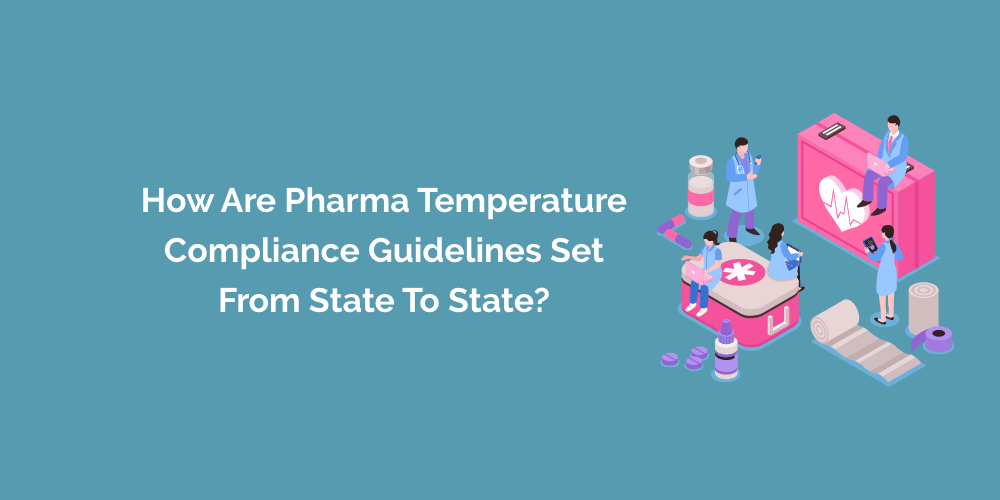Read time < 3 mins
Pharma Temperature Compliance Guidelines:
This is a very common question for those in the business of transporting pharmaceutical goods including medications and vaccines. Doing so can be a complex task where the answers to compliance questions can change the minute you cross a state line.
For example, in California the freezing temperature requirement for transporting medications and vaccines is anything below 5 degrees Fahrenheit, and the state requires that shipments are tracked using a temperature monitoring device. Just a state away in Arizona, however, the freezing temperature requirement is also below five degrees, but cannot go lower than -58 degrees Fahrenheit. And the state of Nevada also requires freezing to not exceed -58 degrees Fahrenheit, but specifically requires the use of a programmable temperature monitoring device.
So, how can you know that you’re meeting the guidelines for a particular state once your reefer trucks cross that state line? It’s generally a matter of relying on the four agencies that set guidelines from state to state. These are the U.S. Food & Drug Administration, the Centers for Disease Control and Prevention, State Boards of Pharmacy, and the U.S. Pharmacopeial Convention (USP).
In general, most agencies look to the USP as the guide to follow when making and amending regulations on pharmacy temperature compliance guidelines, but a change by any of the four agencies mentioned will typically have an effect on all of the others.
National Standards for Vaccines and Medications:
The FDA sets regulations at the national level. It works directly with manufacturers to set guidelines on what temperatures should be maintained during the transport and storage of vaccines and medications. The FDA defines the conditions necessary to maintain the safety and integrity of a specific pharmaceutical or biologic, including proper humidity, light exposure, room temperature, and minimum or maximum temperature.
The CDC also works at the national level. In its case, the agency oversees programs that have a major impact on implementing pharmaceutical temperature monitoring from state to state. Its Vaccines for Children (VFC) program has set the standard on vaccines, defining how they should be handled and stored. The federally funded program is executed at the state level in cooperation with state health departments, which have the authority to create their own rules.
The USP sets the standards for defining acceptable temperature ranges to keep pharmacy shipments, namely medications and vaccines, safe at the state level. It does not, however, govern the methods by which this compliance should be monitored. For example, the USP has nothing to do with the reports companies must provide to ensure safe temperature variances were maintained during a pharmacy shipment.
Regulations at the State Level:
At the state level, each has its own State Board of Pharmacy. This is largely where confusion occurs for those shipping pharmacy products because there is no overarching federal agency governing these Boards. That means temperature monitoring standards can vary from state to state. To ease some of the confusion, over a dozen states use USP standards, or have modeled their own standards using USP as a guide.
Therefore, when the USP adjusts a temperature range specification many of the State Boards of Pharmacy do so as well. Each state can effectively choose to make USP guidelines law and enforce that law by performing inspections, requesting temperature data logs, and imposing determined fines for noncompliance.
It’s important for companies and their distributors to get in touch with each state’s board prior to shipments traveling into states for which they may not know the specific regulations or guidelines. It’s also important to keep on top of changes that occur in compliance regulations at the national level.
Once those guidelines have been determined, shipments should be monitored using real-time temperature monitor that allows distribution managers to know what’s happening with a shipment at all times. It’s crucial to choose a monitor that sends alerts in real time the moment a temperature variance occurs. It’s also crucial to choose a monitor that features GPS tracking in order to know where your shipment is at all times and ensure you’re compliant as you travel from one state to the next.
tempCube's solution is the gold standard in real-time temperature monitoring for vaccines and medications. Our temperature monitoring devices feature GPS tracking and send an immediate alert via SMS/text message if a temperature variance occurs. If you’d like to learn more about ensuring that your pharmacy shipments meet compliance regulations, let us show you how today.
Buy now








